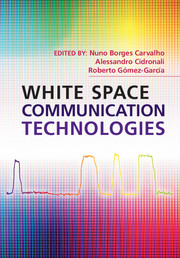Book contents
- Frontmatter
- Contents
- List of contributors
- Preface
- List of abbreviations
- Part I White space technology signal processing and digital design
- 1 White space technology, the background
- 2 Transceiver challenges for white space radio
- 3 Front-ends for software-defined radio
- Part II Adaptable receivers for white space technologies
- Part III Adaptable transceivers for white space technologies
- Index
- References
2 - Transceiver challenges for white space radio
from Part I - White space technology signal processing and digital design
Published online by Cambridge University Press: 05 October 2014
- Frontmatter
- Contents
- List of contributors
- Preface
- List of abbreviations
- Part I White space technology signal processing and digital design
- 1 White space technology, the background
- 2 Transceiver challenges for white space radio
- 3 Front-ends for software-defined radio
- Part II Adaptable receivers for white space technologies
- Part III Adaptable transceivers for white space technologies
- Index
- References
Summary
Introduction
The availability of white space spectrum offers many new opportunities to provide the public with abundant access to broadband data services and enable communications between remote equipment and sensors. However, every new technology opportunity also carries with it new challenges that must be addressed to realize the benefits. The challenge for white space radio applications is that the receiver must be tolerant to the high levels of interfering signals that may be present and the restriction that the transmitter may not interfere with existing services. These two challenges impose heavy restrictions on the radio architectures used to meet white space radio system performance expectations. This chapter quantifies several of the restrictive transceiver requirements that a white space radio must meet. In the US, white space radio applications are permitted to use broadcast television spectrum that is not being used by broadcast television or other local services. The white space spectrum is divided into different parts according to the allocation of broadcast television channels: 2, 5–6, 7–13, 14–36, and 38–51. Channels excluded from white space use include channels 3 and 4 that are protected for video RF modulators commonly used to upconvert DVD, video tape, and video game signals for use with a television tuner, and channel 37 as it is reserved for radio astronomy applications. Each white space channel has an available bandwidth of 6 MHz.
- Type
- Chapter
- Information
- White Space Communication Technologies , pp. 40 - 57Publisher: Cambridge University PressPrint publication year: 2014



